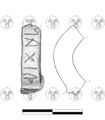IT-8 potsherd
| Object | |
|---|---|
| Classification: | handle |
| Archaeological type: | Henkelbecher |
| Material: | pottery |
| Size: | length: 4.6 cm, diameter: 1.3 cm |
| Condition: | fragmentary |
| Archaeological culture: | La Tène A |
|
| |
| Site: | Fliess (Tirol, Austria) |
| Field name: | Pillerhöhe |
| Archaeological context: | fairground |
| Coordinates (approx.): | 47° 7' 3.97" N, 10° 40' 3.11" E |
| Find date: | 1996 |
| Find circumstances: | excavation |
| Current location: | Archäologisches Museum Fliess (on exhibition) |
| Inventory Nr.: | Pi 293/96/1 |
|
| |
| Inscription: | IT-8 (piθan[) |
Images
|
Object IT-8 potsherd with inscription IT-8.
|
Object IT-8 potsherd with inscription IT-8.
|
Commentary
Published in Tschurtschenthaler & Wein 1998: 247; Tschurtschenthaler & Wein 2002: 663–664.
Image in Tschurtschenthaler & Wein 1998: 249, fig. 24 (photo).
The fragment is most probably the handle of a ceramic vessel type Henkelbecher (cf. Tschurtschenthaler & Wein 2002: 663). Cylindrical cross section. Fine clay, from brown to dark grey in colour, moderately tempered with fine-grained sand and cast gold as well as argentine mica; reduction firing; burnished.
The handle was found in 1996 during the annual excavations on the Pillerhöhe executed by the Institute of Classical Archaeology of the University Innsbruck since 1992. It was discovered in the area of the fairground near the burnt-offerings site. See Pillerhöhe for more information about the archaeological context.
The major part of these offerings does not indicate burn marks and can be considered deposit offerings whereas sometimes fragments of the same object were spread over the entire area of the fairground. However, it can be supposed that the place of discovery does not correspond to the place of deposit. Probably the spreading is caused secondarily (cp. Tschurtschenthaler & Wein 1998: 236).
A large number of the entire earthenware from the fairground of the Pillerhöhe is presented by the vessels type Henkelbecher. However, in the majority of cases only the handles of this ceramic type are extant (cp. Tschurtschenthaler & Wein 1998: 247; Tschurtschenthaler & Wein 2002: 663).
Concerning the entire pottery discovered on the Pillerhöhe it can be stated that the quantity of ceramic increases during the La Tène period. However, the major part presents early Fritzens-Sanzeno-pottery. Tschurtschenthaler and Wein, in accord with Gleirscher, propose a dating to the Early La Tène period (cp. Tschurtschenthaler & Wein 1998: 247, fn. 110 and 113; Tschurtschenthaler & Wein 2002: 663–664, fn. 110 and 113). Therefore the above-mentioned dating to La Tène A is concerted with this common chronological classification of the pottery from the Pillerhöhe.

